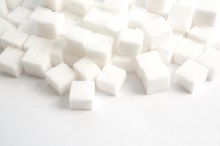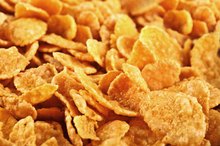Is Glucose Organic or Inorganic?
Any natural molecule that consists of carbon and hydrogen atoms is considered organic. Since glucose is made up of carbon, hydrogen and oxygen atoms, glucose is organic. Glucose is a monosaccharide, the smallest biologically active form of a sugar or carbohydrate. Plants and animals use it as a vital energy source, a necessity to maintaining cellular activity. Dietary glucose can be found in plants and vegetables. Glucose is also a major component of sucrose, or table sugar. Excessive glucose levels can be detrimental to health.
Glucose is one of smallest units of carbohydrates and the primary energy source for your body. Every carbohydrate in your diet is digested and broken down to this simple sugar, which your body can easily burn for energy. Like many of the molecules in your body, glucose is an organic molecule.
Organic Compounds
One way to determine if a molecule is organic or inorganic is to look at its molecular formula. With some rare exceptions, organic molecules contain carbon atoms that are typically linked to hydrogen, oxygen or nitrogen atoms. Glucose contains six carbon atoms, 12 hydrogen atoms and six oxygen atoms, which makes it and any other carbohydrate an organic compound.
Glycolysis
Why Do We Need Glucose in Our Diet?
Learn More
Glycolysis is an important chemical pathway in our cells, and the first stage of cellular metabolism. Similar to how an old steam-powered locomotive would burn coal as a source of fuel, glycolysis "burns," or degrades, glucose to be utilized as a source of fuel for cells. Glycolysis from a single molecule of glucose will synthesize, or create, two molecules of adenosine triphosphate, or ATP. While other monosaccharide sugars such as fructose and maltose can also be utilized in glycolysis, glucose is the most efficient
- Glycolysis is an important chemical pathway in our cells, and the first stage of cellular metabolism.
Aerobic Metabolism
From glucose, glycolysis will synthesize ATP molecules and pyruvate. Under anaerobic conditions or low oxygen conditions, such as in muscle, pyruvate will become lactic acid, a waste product of this pathway. However, in high oxygen levels, as is the case for most human and animal cells, pyruvate will be utilized in two other pathways, the citric acid cycle and oxidative phosphorylation, which will in turn synthesize several more molecules of ATP.
- From glucose, glycolysis will synthesize ATP molecules and pyruvate.
- Under anaerobic conditions or low oxygen conditions, such as in muscle, pyruvate will become lactic acid, a waste product of this pathway.
- **
Photosynthesis
Is Lactose an Aldose?
Learn More
While animal cells only consume glucose, plant cells will also synthesize glucose through the process of photosynthesis. During photosynthesis, plants use important components from the soil, water and sun to develop glucose. This glucose can then be used in glycolysis to power cellular function in the cells. Due to photosynthesis, plants are an excellent source of glucose and for this reason, an important dietary component of animals. According to Dr. John Blamire from Brooklyn College, 80 percent of human glucose needs comes from ingesting plants.
- While animal cells only consume glucose, plant cells will also synthesize glucose through the process of photosynthesis.
- During photosynthesis, plants use important components from the soil, water and sun to develop glucose.
Health Problems
While glucose sugars are vital and essential for our survival, excessive amounts of this energy source can be detrimental to our health. Erratic glucose or blood sugar levels are often a sign of diabetes, a disease in which our bodies cannot efficiently utilize glucose as an energy source. There are many causes of diabetes, including genetics and diet. High glucose levels can also have effects in cardiac and renal disease as well as cancer.
- While glucose sugars are vital and essential for our survival, excessive amounts of this energy source can be detrimental to our health.
- High glucose levels can also have effects in cardiac and renal disease as well as cancer.
- **
- Glycolysis is an important chemical pathway in our cells, and the first stage of cellular metabolism.
- Under anaerobic conditions or low oxygen conditions, such as in muscle, pyruvate will become lactic acid, a waste product of this pathway.
Related Articles
References
- Encyclopedia Britannica: Organic Compound
- Georgia State University: Glucose
- Brooklyn College: Role of Carbohydrates
- MedlinePlus: Glucose Test
- National Institute of Diabetes and Digestive and Kidney Diseases. Diabetes diet, eating, & physical activity. Published December 2016.
- American Diabetes Association. The big picture: Checking your blood glucose.
- American Diabetes Association. 6. Glycemic Targets: Standards of Medical Care in Diabetes-2020. Diabetes Care. 2020;43(Suppl 1):S66-S76. doi:10.2337/dc20-S006
- American Diabetes Association. 14. Management of diabetes in pregnancy: Standards of medical care in diabetes-2020. Diabetes Care. 2020;43(Suppl 1):S183-S192. doi:10.2337/dc20-S014
- Porcellati F, Lucidi P, Bolli GB, Fanelli CG. Thirty years of research on the dawn phenomenon: Lessons to optimize blood glucose control in diabetes. Diabetes Care. 2013;36(12):3860-2. doi:10.2337/dc13-2088
- American Diabetes Association. 5. Lifestyle management: Standards of medical care in diabetes-2019. Diabetes Care. 2019;42(Suppl 1):S46-60. doi:10.2337/dc19-S005
- Colberg SR, Sigal RJ, Yardley JE, et al. Physical activity/exercise and diabetes: A position statement of the American diabetes association. Diabetes Care. 2016;39(11):2065-2079. doi:10.2337/dc16-1728
- American Diabetes Association (ADA). Understanding A1C.
- Garber AJ, Abrahamson MJ, Barzilay JI, et al. Consensus statement by the American association of clinical endocrinologists and American college of endocrinology on the comprehensive type 2 diabetes management algorithm - 2019 executive summary. Endocr Pract. 2019;25(1):69-100. doi:10.4158/CS-2018-0535
Writer Bio
Nadia Haris is a registered radiation therapist who has been writing about nutrition for more than six years. She is completing her Master of Science in nutrition with a focus on the dietary needs of oncology patients.









